Autodesk ships Maya 2022
Autodesk has released Maya 2022, a major update to its 3D modelling and animation software, introducing “full USD integration” and adding support for key pipeline technologies like Python 3 and OCIO 2.
There are also new features throughout Maya’s toolset, including a Sweep Mesh system, new procedural rigging tools, a GPU-accelerated Morph deformer, and a new Ghosting Editor for animation.
Autodesk has also released Create VR, a separate concept design app for roughing out 3D forms in virtual reality, then exporting the results to Maya or other DCC software.
Maya 2022 was released as part of a wider series of updates to Autodesk’s Media and Entertainment software, alongside 3ds Max 2022 and MotionBuilder 2022.
At the time of writing, there seems to have been no update to Maya LT, the old cut-down edition of the software for game artists, which always used to be updated in parallel with Maya itself.
Maya 2022 already? What happened to Maya 2021?
If you’re wondering about the version number, with the release, Autodesk has skipped straight from last December’s Maya 2020.4 to Maya 2022, leapfrogging Maya 2021 entirely.
That brings Maya back into line with 3ds Max, which is numbered one year ahead of the actual calendar year.
Both apps get updated at the same rate – one new release roughly every three months – so there are no ‘missing’ Maya updates, despite the break in numbering in the Maya public product timeline.
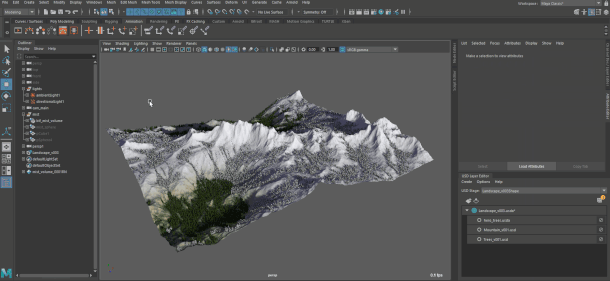
Pipeline integration: new USD plugin, support for Python 3 and OCIO 2
The headline change in Maya 2022 is “full integration” of the Pixar-developed Universal Scene Description (USD) system, now widely adopted in visual effects and feature animation pipelines.
USD support has been available to Maya users since 2019 via Maya USD, an open-source plugin developed jointly by Autodesk, Pixar and VFX houses Animal Logic, Blue Sky Studios and Luma Pictures.
The main change in Maya 2022 is that the plugin has now advanced far enough for compiled binaries to be bundled with the software, rather than users having to build it from the GitHub repo.
Autodesk describes it as enabling artists to “load multiple gigabytes of data within seconds”, edit the assets using Maya’s native tools, the export the results in USD format again.
The implementation provides “robust referencing functionality, nondestructive data editing workflows, and support for complex variants on top of USD”, although support for cameras and lights is still “very limited”.
There are also still restrictions to USD stage creation, layer handling and support for Hydra render delegates. You can find a full list of USD limitations here.
The release also introduces support for two other important pipeline standards: Python 3 and OCIO 2 (OpenColorIO 2), both specified by the current CY2021 spec for the VFX Reference Platform.
Although a number of other VFX software developers have introduced support for Python 3 in their products, Maya is the first major app we’re aware of to support version 2 of OpenColorIO.
Modelling: new Create VR app lets concept designers sketch in virtual reality
The biggest change to the modelling tools available in Maya 2022 is Create VR: a separate virtual reality modelling app aimed at concept design work.
It provides alternative to free third-party tools like Adobe’s Medium, Oculus’s Quill or Gravity Sketch, and provides a set of “simple curve and surface tools” for exploring shapes.
The resulting rough 3D sketches can then be exported to Maya or other DCC applications.
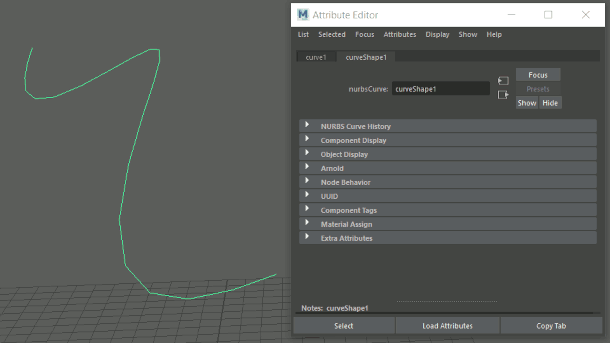
Modelling: new Sweep Mesh system and Game Vertex Count plugin
Within the core software, the main new modelling feature is Sweep Mesh, which generates a 3D mesh by sweeping a cross-section along a guide curve, in a similar way to 3ds Max’s Sweep Modifier.
Users can choose a range of readymade cross-sections, including polygons and curve segements, or use a custom profile curve; and there are a standard set of control parameters.
Game artists get a new Game Vertex Count plugin which shows the vertex count an object will generate after being exported to Unity or Unreal Engine, helping to manage in-game vertex budgets more accurately.
There are also a number of smaller workflow improvements to pivot snapping, extrusion and scene transforms, and lasso selection is now faster. You can find a full list in the online changelog.
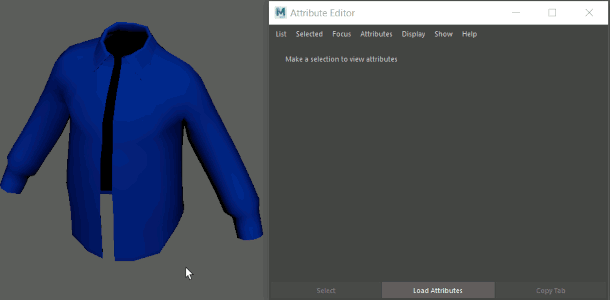
Rigging: new Component Tags system and changes to deformer falloff
There are also what Autodesk describes as new “procedural topology-independent rigging workflows”.
A new system of Component Tags makes it possible to create named groups of vertices, edges or faces, as shown above, then use expressions to control which deformers act on those parts of a mesh.
The groups are node-independent and tag membership can be modified on the fly.
The update also changes the way in which Maya handles falloff for deformers. The changes are quite difficult to summarise, but should make it quicker to set up and edit falloff effects.
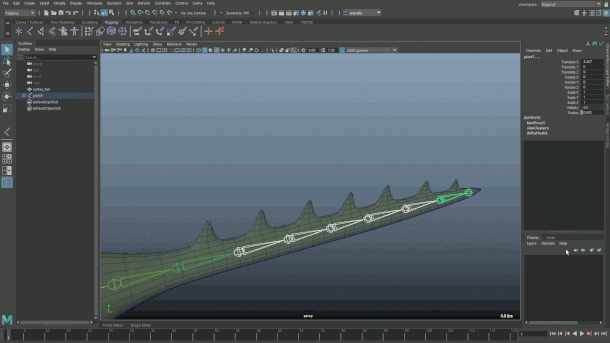
Rigging: new Solidify and Morph deformers
In addition, there are two new deformers: Solidify and Morph.
Solidify, shown in the image above, makes it possible to define areas on a mesh more resistant to deformation, such as rigid parts of clothing like buttons, or the spikes on the monster’s tail.
Morph is described as “like a GPU-accelerated version” of the blend shape deformer, and can be used to apply shape-based deformation to a mesh: for example, for facial animation.
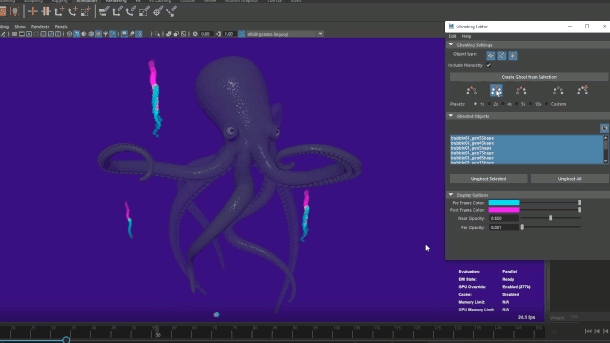
Animation: new Ghosting Editor, plus updates to the Graph Editor and cached playback system
New animation features include the new Ghosting Editor, which makes it possible to control the appearance of motion ghosts on a global basis, rather than having to edit the attributes for each mesh individually.
In the image above, it can be seen in use to set up separate colours for previous and succeeding frames of animation for the bubbles rising up between the octopus’s tentacles.
The Graph Editor gets a new Peak Removal Filter to clean up noisy animation data, removing unwanted spikes from animation curves in the same way as its namesake in MotionBuilder.
A separate Smooth filter (Gaussian) option automatically removes jittering and noise in curve channels.
Workflow improvements new options for preserving curve tangents and for Time Slider bookmarks, and a new Additive blending mode for animation clips in the Time Editor.
In addition, the cached playback system for playing back animations interactively rather than rendering Playblasts can now be used with the Time Editor and combined with GPU deformation.
The option to use cached playback for simulations introduced in Maya 2020 is also now on by default.
Improvements to start-up behaviour and plugin security
Other performance and workflow improvements include changes to start up.
In addition to making start up faster, Maya no longer steals focus from other applications, making it possible to carry on working; and now only displays its UI once it is actually possible to interact with it.
It is also now possible to flag specific commands or plugin locations to be blocked when Maya loads them in the Preferences window, helping to load files received from untested sources more safely.
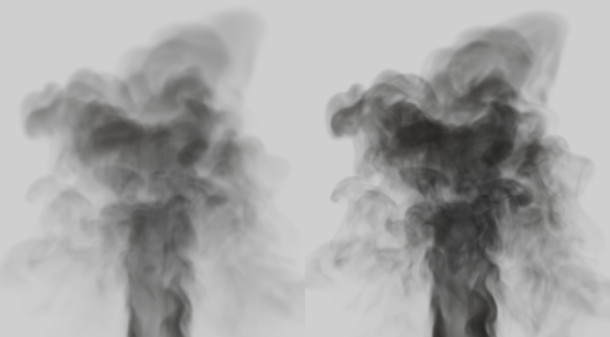
The Bifrost plugin’s new post_refine_aero node enhances detail in smoke effects after simulation.
Plugins: updates to Bifrost for Maya, MtoA and Substance for Maya
Outside the core software, the Bifrost for Maya multiphysics plugin gets a few important new features, following a major update in Maya 2020.4.
The new version, Bifrost for Maya 2.2.1, makes it possible to resume a simulation from a cached frame on disk, and to enhance detail in Aero smoke and gaseous fluids after simulation.
The Maya to Arnold plugin has also been updated with MtoA 4.2.1, adding support for the new features introduced in Arnold 6.2 earlier this year, including the new post effects nodes like the Light Mixer.
According to the release notes, both the Substance for Maya plugin, and the integration plugin for the Rokoko mocap library added in Maya 2020.1 have also been updated.
At the time of writing, we can’t find any details about what’s changed, but will update if we do.
Updated 31 March 2020: Autodesk told us that a number of features from previous updates, including the Rokoko integration plugin, were “rolled up in the Maya 2022 release notes to get them more visibility”, but that there are no changes to it in Maya 2022.
Pricing and availability
Maya 2022 is available for Windows 10, RHEL/CentOS 7.6-7.9 or 8.2 Linux and macOS 10.13+. Create VR is available for Windows 10 only and requires a compatible Oculus or HTC Vive headset and controllers.
The software is rental-only. Since the previous release, the cost of subscriptions has risen to $215/month, up $10/month; or $1,700/year, up $80/year.
In many countries, artists earning under $100,000/year and working on projects valued at under $100,000/year, qualify for Maya Indie subscriptions, now priced at $280/year.
Read an overview of the new features in Maya 2022 on Autodesk’s blog
Read a full list of new features in Maya 2022 in the online release notes
